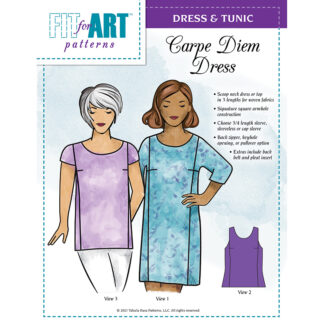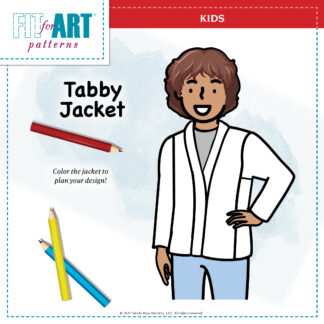
We have been playing around with an asymmetrical band front for the Tabula Rasa Jacket for many years. It is now time to show you the adjustments needed to change your Tabula Rasa Jacket pattern into this less predictable style.

You have recently seen a garment made in this style in Carrie’s post on Double Benefits with Cotton Jacquard. Carrie’s vest has this offset front entry and shortened band. You have also seen it in our post Bathrobe Needed, though the pattern work was not well described. Here is a clearer description of the necessary pattern adjustments.
Clean off the sewing table and prepare to do some pattern work. You will need a roll of pattern paper, your personally adjusted Tabula Rasa Jacket pattern, tape, a pencil, a curved ruler and a straight ruler. If these are not tools you have on hand, you can purchase them in the Pattern Drafting Kit available in the Fit for Art store.

Only the front pattern needs to be adjusted for this design change. Lay the front pattern on the table and unroll pattern paper on top of it, completely covering the pattern. Place a couple pins around the edges to connect the two layers or use some weights or strategically position the tape dispenser to anchor the paper to the pattern being copied.
It is smart to first draw the grainline and the three balance lines on the new pattern so if the layers get separated, they may be easily realigned. Next, draw the cutting lines around the entire pattern and add in the dart (or darts). Remove the new pattern from the original and label it Asymmetrical Front for the TRJ.

Now place an easily visible dot at the place where the top balance line joins the front cutting line. Lay the straight ruler along the middle balance line, placing the short end along the grain line and allowing the ruler to extend across the pattern. Observe the distance between the grain line and the cutting line. Draw a line that extends from the grain line to the center front and beyond the original center front the same distance as measured. Repeat at the lower balance line. On my Large pattern with the CD front, this was about 5”.

Use the curved ruler to connect the end of this new line to the dot created at the high balance line. Be sure the ruler blends into the original cutting line above the dot for at least 3/8”.

Step back and observe the line drawn. If it seems graceful enough, then complete the pattern work by laying the ruler parallel with the original cutting line and draw the new front cutting line that creates an asymmetrical front from the neck curve to the hem.

If you wish to add an asymmetrical hemline to this new front, allow the new front line to extend down beyond the hem line as desired, 3″ to 5” is a good start. Then angle the straight ruler to draw an angled front hemline for the right side of the jacket. Allow the original hem line to remain for the left side of the jacket. Label each hemline and note that to cut the left side, the pattern should be flipped over and the asymmetrical hemline folded away to create the offsetting hems.


Finish the pattern work by adding a double-turned self facing down the straight front cutting line. Draw the first fold line 1¼” beyond the new cut line and then add a second fold line an additional 1” beyond the first facing line. Let these lines extend at least 1” above the front, so they can be trued to the pattern following the new neck curve.

Cut out the pattern, leaving extra paper for the self facing. Fold back the pattern’s double fold facing so it sits under the front. Use scissors to trim off the extra facing at the hem and the front band edge.


At our recent retreat, I demonstrated how to make a template, not a complete new pattern, so the original TRJ front pattern could be adjusted easily for this new front and neckline. If this is your preference, instead of tracing off the complete front pattern, trace the original pattern from the grain line only before adding the new neck curve, facings and hemline. Make a note to align the template’s edge with the grainline on the TRJ pattern piece.

I am working on a vest using this fresh neckline without the asymmetrical hemline. I simply folded up the pointed pattern for the right front and cut it out with an even hemline all around.

When constructing this new neckline, after sewing the shoulder seam, double turn the facing, interfaced if needed, and then stitch it into place with a topstitch or by hand. Cut the front band based on the measurement of the neck edge from facing edge to facing edge.

As you can see, my vest is ready for the band to be added. However, this band is a bit of a challenge! It is being made with a batik backing fabric and a strip of old pillow case painted, pieced and embroidered with an abstract design. Watch our social media this week to see it positioned and finished. Two years ago I made a hot pink tee to wear under this vest, but the handwork on the band took a bit of time. So glad the vest is finally ready to be constructed!

Try out this fun style to add interest to your Tabula Rasa Jacket sewing. Be sure to send us photos of the fun things you create in this new style or post them with our hashtags.
Happy Sewing, RAE







So happy to see this modification after seeing some sample garments at the last retreat I attended! You have me thinking about a spring jacket. Thanks so much for a nice surprise today.
Hi Sue, enjoy this little gift, we missed you at the retreat but cannot wait to see what you do with this new design.
Great job. Would I follow a similar principle If I wanted to make the back Asymmetrical ?
Any time you wanted to make something Asymmetrical you can use this principal. I would suspect if you were adding an asymmetrical opening to a back, it might not dip down as far. For the front, it needs to dip down far enough to play nicely with the bustline!